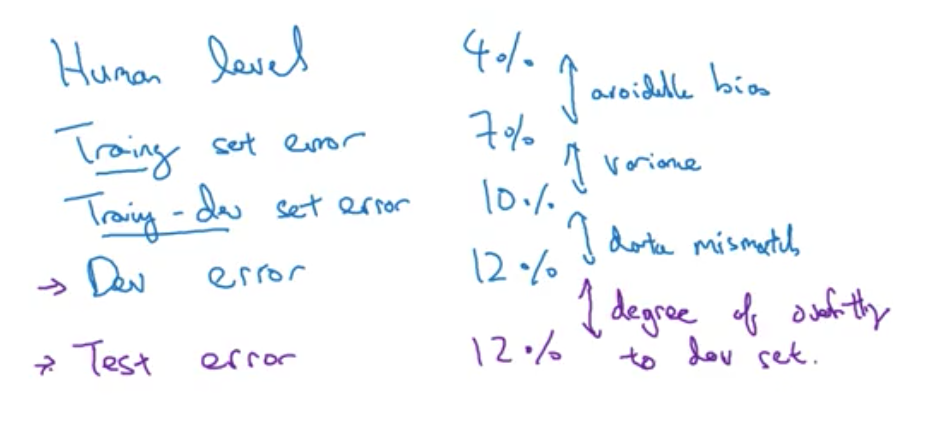Error analysis
Carrying out error analysis
- Manual examining errors your classifier is making, can help you figure out what to do next.
- Question: should you try to make your cat classifier do better on dogs?
- Error analysis procedure:
- Get ~100 mislabled dev set examples.
- Count are how many are dogs.
- If it's 5%, you could improve error from 10% to 9.5%
- May not be best use of your time, but at least provides a "ceiling on performance".
- If it's 50%, then you can be sure this is the best use of your time.
- Can evaluate ideas in parallel:
- Create a spreadsheet with different examples and why they were miscategorised to start to figure out patterns and where you get the best bang for buck with improvements.
Cleaning up incorrectly labeled data
- Deep learning algorithms can handle some random errors in the training dataset, if that dataset size is big enough.
- Deep learning is less robust to systematic errors.
- With incorrectly labeled examples in dev/test set, can add an extra column to the error analysis spreadsheet described previously with incorrectly labelled examples.
- If the % is high enough, maybe it's worth your time to fix.
- Want to look at 3 examples to decide:
- Overall dev set error.
- Errors due to incorrect labels.
- Errors due to other causes.
- If cleaning up dev set, want to make sure you clean both dev and test set.
- Consider examples your algo got right, as well as wrong.
Build your first system quickly and iterate from there
- Having some trained system lets you start analysing things like bias/variance.
Mismatched training and dev/test sets
Training and testing on different distributions
- People want to have as much data as possible in the training set, and will to use data from a different source or "distribution" than the dev/test set.
- Example: expected data is blurry phone pics but you don't have enough for a training set, so you find high quality online.
- Option 1: mix high quality with blurry and shuffle, then split to training/dev/test.
- Problem: won't get enough of the expected images in the dev/test set.
- Option 2: put the high quality images in the training set, with maybe some blurry images and ensure dev / test set has all blurry images.
- Speech recognition example: building a speech recognition mirror.
- Training data might come from a big archive of purchase data and collected data
- Dev/test comes from recordings from the rear view mirror.
Bias and variance with mismatched data distributions
- Can be difficult to evaluate your training performance when training and dev are from different distributions.
- Add an extra set called training-dev set from the training distribution.
- Called a "data mismatch" when performance is good on training-dev but not dev.

- No "super systematic" ways to go about addressing data mismatch.
Addressing data mismatched
- Carry out manual analysis and try to understand difference between training and dev set (should ignore the test set).
- Dev set may be noisy - try to augment dataset with noisy data.
- Artificial data synthesis
- Add car noise to the background of audio recordings, if it matches the dev set.
- Car image recognition: could you generate a training set from computer graphics?
- Likely to overfit on the computer graphics.
Learning from multiple tasks
Transfer Learning
- Transferring learning from one model to another domain.
- Remove last layer of model and retrain with another dataset.
- Learnings from another dataset, could help speed up your dataset (already knows about lines, curves, objects etc).
- Options for retraining models:
- If you have a small dataset, just retrain last layer (or last two).
- Lots of data? Could retrain all layers.
- Could add additional layers of the network for certain speech recognition tasks.
- Transfer learning makes sense if:
- Task A and B have the same inputs.
- You have a lot more data for A than B.
- Low level features of A (shapes, features etc) could be helpful for Task B.
Multitask learning
- The process of assigning multiple output labels instead of a single from multiple classes (like in Softmax regression).
- Loss function takes into account the loss from each output label:
m1i=1∑mj=1∑4L(y^i(i),yj(i))
- Could also train 4 separate neural networks, but when the output classes can share information, you tend to get better performance with 1 network.
- Multitask learning makes sense if:
- Training on a set of tasks that could benefit from having lower-level features.
- Amount of data you have for each task is quite similar.
- Can train big enough network to do well on all tasks.
- Only time multi-task learning may be bad for perform? If you can't train a big enough network (according to Rich Carona).
End-to-end deep learning
What is end-to-end deep learning?
- Take multiple stages of a data pipeline and replace with a single neural network.
- Speech recognition example: might have a pipeline that takes audio and extracts features (phonemes etc), then another that finds words and returns transcript.
- End-to-end: take audio, return transcript.
- Face recognition at turnstile:
- Found it better to detect face first, then crop the face out to feed into face classifier. Example where multiple neural nets works better than end-to-end analysis.
- Machine translation example:
- With big enough dataset, end-to-end seems to work well. Smaller datasets may require some advanced feature engineering techniques.
When to use end-to-end and when not to use
- Pros:
- Let the data speak for itself.
- Less hand designing of features.
- Cons:
- Need very large dataset.
- Excludes potentially useful hand-designed components.
- Key question: do you have enough data to learn the function of the complexity needed to map x to y?
